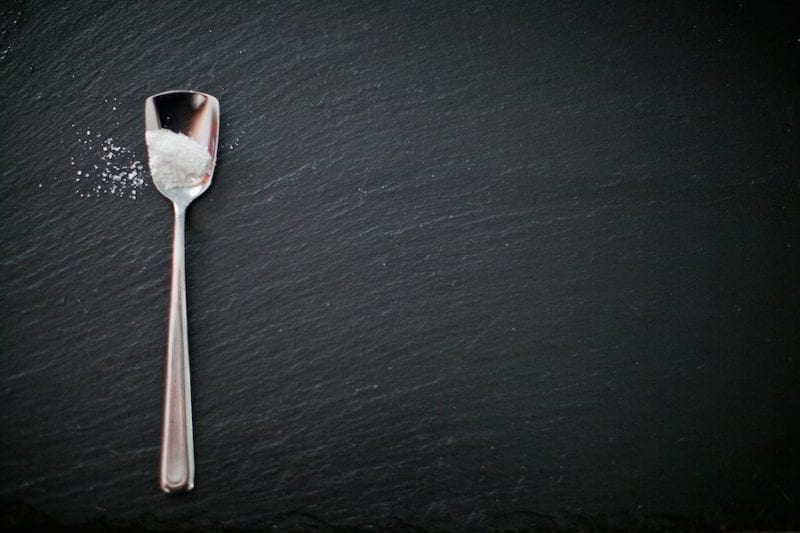Tricky health information is all around us, yet rather than toss up our hands in defeat, we’re taking things step-by-step with help from our favorites over at Chalkboard Mag. Below they’re sharing about salt, the good, the bad and the pink. Keep reading for more!
It’s no secret, salt has a bad rep. Processed bleached salt does contribute to the physical imbalances and issues that have fueled a salt backlash over the past couple of decades, but natural salt, in it’s completely raw state, is a horse of a different color. Unrefined salt is a vital source of trace minerals that can provide some serious health benefits.
Sodium chloride (NaCI), or salt as we know it, is an ionic compound some have come to fear. It’s associated with high blood pressure and hypertension, so more and more health advocates, food companies and restaurants are going low-sodium or sodium-free. However, this mineral is a vital substance that is needed for the survival of almost all living creatures. Salt makes up our extracellular fluid and is essential to help us regulate and maintain a stable pH in our blood and organs. Moreover, it ensures our entire bodily system is functioning correctly and efficiently.
Here’s what natural health pro Shelley Young of pH Miracle says about this vital substance, “Salt helps to regulate the water content of the body. Water regulates itself, working its way into into the interior of all our cells. It has to get inside each cell to cleanse and extract the toxic wastes of cell metabolisms. Salt forces some water to stay outside the cells and balances the amount of water that must stay outside the cells. The two ‘oceans’ of water in the body are these two oceans held inside and outside the cells of the body. Good health depends on a highly delicate balance between the volume of these oceans, and this balance is achieved by salt – unrefined salt.”
Natural unprocessed sea- and mountain-sourced salts are completely different from their processed counterparts. Salt is an essential nutritional compound and along with the many trace minerals it provides, it can help us achieve an alkaline state and prevent disease. The key to using this vital mineral correctly is in sourcing the right kind. Here’s what you should know:
WHY IS SALT NECESSARY?
FOR THE HEART
Contrary to belief, in its natural state, salt may actually help to stabilize an irregular heartbeat and regulate blood pressure.
REMOVAL OF TOXINS
We need it to help us process toxins and remove acidity from our cells and body, particularly brain cells.
FOR GOOD DIGESTION
It is essential for the absorption of food through the intestinal tract and may actually help boost our digestive capabilities.
FOR BONES AND MUSCLES
It is a natural antihistamine, essential for the prevention of muscle cramps, and vital aspect nutrient that makes our bones strong and firm. Osteoporosis may be caused by the result of an imbalance of these natural electrolytes and water shortage in the body.
HORMONE BALANCE
Salt helps to balance hormones and other symptoms that may be associated with hormone imbalance.
ESSENTIAL NUTRIENTS
In its natural state it contains about 80 mineral elements that the body needs.
SO, WHAT’S SO WRONG WITH TABLE SALT?
HEALTH RISKS
Not to be confused with raw salt in its natural state, table salt is bleached and processed salt, which is directly linked with hypertension and high blood pressure. When table salt is consumed, blood pressure will rise in an attempt to move these toxic elements away from the heart. This is why people with high blood pressure are told to avoid salts, but to be clear, it is specifically these processed salts that contribute to this effect and disease.
The key to using this vital mineral correctly is in sourcing the right kind.
SYNTHETIC CHEMICALS
Table salt is commonly used in restaurants, fast food and other processed foods and contains synthetic chemicals that also contribute to disease including anti-caking agents, aluminum derivatives and bleach, used to create a clean white color. Besides its flavor, there are no health benefits to this type of salt and it should be avoided whenever possible.
WHAT TYPE OF SALT SHOULD WE BE SOURCING?
PINK HIMALAYAN SALT
Pink salt is an unrefined form of salt that comes from naturally formed sea and mountain beds. It is commonly sourced from the Himalayas, Mediterranean, and Hawaiian islands. On average it contains over ninety health-promoting trace minerals, including phosphorus, bromine, boron, zinc, iron, manganese, copper and silicon. Source it in its raw unprocessed state.
TCM pick: Premier Pink Salt
GREY SEA SALT
Celtic grey sea salt is harvested in Brittany, France near the Celtic Sea using a traditional 2,000 year of Celtic method that is essential to ensuring its nutrition. In order to keep the trace minerals intact, it is harvested by hand raking the crystals from a layer of clay and sand. The grey color comes from the residual clay that stains the salt crystals and provides the additional trace minerals. With a similar nutritional profile, cleric grey salt is also an excellent source of these trace minerals that help to alkalize the body.
TCM pick: Light Grey Celtic Sea Salt
There are so many different types of unprocessed salts to be explored all with ranging flavor profiles and varying trace minerals. Try them all! For 30 more reasons why unprocessed salt is essential, learn more and click over to Alkalizing 101: Salt and Vibrant Health.
Image via Hart & Honey












1 comment
I’ve just started incorporating more salt into my diet because I have really low blood pressure. I didn’t know that salt had so many benefits for our bodies! Thank you for sharing this article, it was really helpful!